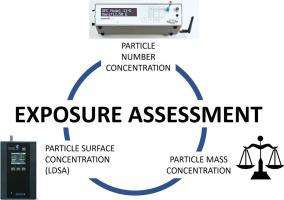NanoImpact ( IF 4.9 ) Pub Date : 2023-03-21 , DOI: 10.1016/j.impact.2023.100459 Franco Belosi 1 , Antti Joonas Koivisto 2 , Irini Furxhi 3 , Jesús Lopez de Ipiña 4 , Alessia Nicosia 1 , Fabrizio Ravegnani 1 , Simona Ortelli 5 , Ilaria Zanoni 5 , Anna Costa 5

|
Engineered Nanomaterials (ENMs) have several uses in various industrial fields and are embedded in a myriad of consumer products. However, there is continued concern over the potential adverse health effects and environmental impacts of ENMs due to their unique physico-chemical characteristics. Currently, there are no specific international regulations for various ENMs. There are also no Occupational Exposure Limits (OEL) regulated by the European Union (EU) for nanomaterials in the form of nano-objects, their aggregates or agglomerates (NOAA). For ENMs the question of which metric to be used (i.e., mass, surface area, number concentrations) to determine the exposure is still not resolved. The aim of this work is to assess the worker exposure by inhalation in an industrial spray coating process by using all three metrics mentioned above. Two target ENMs (N-doped TiO2, TiO2N and AgNPs capped with a quaternized hydroxyethyl-cellulose, AgHEC) generated for industrial-scale spraying processes were considered. Results showed that the averaged particle number concentration (10–100 nm) was below 2.7 104 cm−3 for both materials. The Lung Deposited Surface Area (LDSA) was in the range between 73 and 98 μm2cm−3 and the particle mass concentration (obtained by means of ICP-EOS off-line analysis) resulted below 70 μg m−3 and 0.4 μg m−3 for TiO2 and Ag, respectively. Although, the airborne particles concentration compared well with the NIOSH Recommended Exposure Level (REL) limits the contribution to the background, according to EN 17058 (Annex E) was significant (particularly in the particle number and PM1 mass concentrations). We successfully evaluated the worker exposure by means of the different airborne particles' metrics (number, surface and mass concentrations). We concluded that worker exposure assessment involving ENMs is a complex procedure with requires both real time and off-line measurements and a deep investigation of the background.
中文翻译:

工业喷涂过程中使用不同气溶胶指标进行职业暴露评估的关键方面
工程纳米材料 (ENM) 在各种工业领域有多种用途,并嵌入到无数消费品中。然而,由于其独特的物理化学特性,人们一直担心 ENM 的潜在不利健康影响和环境影响。目前,还没有针对各种 ENM 的具体国际法规。欧盟 (EU) 也没有针对纳米物体、其聚集体或附聚物 (NOAA) 形式的纳米材料规定职业接触限值 (OEL)。对于 ENM,使用哪种度量标准(即质量、表面积、数量浓度)来确定暴露的问题仍未解决。这项工作的目的是通过使用上述所有三个指标来评估工业喷涂过程中工人吸入的暴露情况。如图 2 所示,考虑了为工业规模喷涂工艺生成的 TiO 2 N 和用季铵化羟乙基纤维素 (AgHEC) 封端的 AgNP。结果表明,两种材料的平均粒子数浓度 (10–100 nm) 均低于 2.7·10 4 cm -3 。肺沉积表面积 (LDSA) 在 73 和 98 μm 2 cm -3之间,颗粒质量浓度(通过 ICP-EOS 离线分析获得)低于 70 μg m -3和 0.4 μg m -3对于 TiO 2和银,分别。尽管空气中的颗粒浓度与 NIOSH 推荐暴露水平 (REL) 相比很好,但根据 EN 17058(附件 E)限制了对背景的影响(特别是在颗粒数量和 PM1 质量浓度方面)。我们通过不同的空气传播颗粒指标(数量、表面和质量浓度)成功地评估了工人的暴露情况。我们得出结论,涉及 ENM 的工人暴露评估是一个复杂的过程,需要实时和离线测量以及对背景的深入调查。



























 京公网安备 11010802027423号
京公网安备 11010802027423号